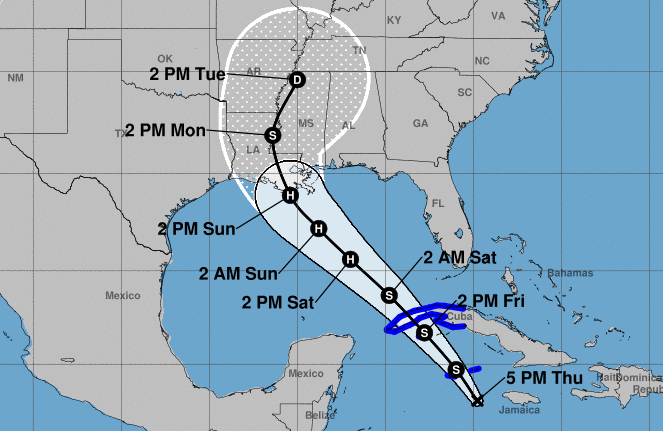Hurricane Ida was rapidly intensifying early Sunday, becoming a dangerous Category 4 hurricane on track for a potentially devastating landfall on the Louisiana coast while emergency officials in the region grappled with opening shelters for displaced evacuees despite the risks of spreading the coronavirus.
The National Hurricane Center predicted Ida would become an extremely dangerous Category 4 hurricane with 130 mph (209 kph) winds — that happened early Sunday ahead of an expected afternoon landfall. The storm arrived on the exact date Hurricane Katrina ravaged Louisiana and Mississippi 16 years earlier.
Given very high Gulf sea surface temperatures and a slow-moving storm, it's possible Ida might even reach Category 5 wind speeds (greater than 157 mph, 252 kph, 137 kt) before landfall.
Storm damage is a function of wind, rain, and storm surge, a rise in the overall level of water similar to a tsunami (though lasting much longer), itself interacting with tides, as well as the size of the storm ("wind field"), and the terrain and preparedness of the regions it strikes. The most dangerous side of Northern-hemisphere storms tends to the the north-east quadrant, so that storms passing to the west of a location tend to do the most damage. Ida is tracking about 10--20km (6-12 mi) west of downtown New Orleans. The final factor is response: rescue, recovery, and emergency shelter and services.
Another factor for Gulf hirricanes is the oil industry. This is a mainstay of the region, and there are numeous offshore platforms, onshore refineries and processing plants, storage facilities, pipelines, and support services including ports and harbours. All of these are affected by the storm. Reports are that 91% of Gulf oil production has been shut down.
Ida is a smaller but more intese storm than Katrina, 16 years ago. Rainfall levels are higher, storm surge is lower, and wind speeds look to be higher. The major damage mechanism of Katrina was the overwhelming of New Orleans's levee system. There's been substantial improvement of that in the decade-and-a-half since. Peak storm surge looks to be 12--15', as compared with an estimated 20' for Katrina, though the peak measured surge from Katrina was 12'. Ida is slow-moving, meaning that rainfall totals will be greater than Katrina (20"+ vs. 15"), over the duration of the storm. Ida's track will take it up the Mississippi-Ohio river system over the next five days, ending as a long band of intense rainfall over the Appalachians, with the cone of probability extending from a bare-skimming of northern Georgia to Pennsylvania and New York. That's where the system center might fall. The projected track crosses Louisiana, Mississippi, Tennessee, West Virginiana, Maryland, Pennsylvania, New Jersey, New York, and southern New England before heading into the Northern Atlantic. That track is similar to the one followed by Katrina.
The storm errupted and intensified quickly enough that there was no time to organise an evacuation of New Orleans itself. I'm bothered by this fact, and suspect this aspect will be revisited in the future. At-risk coastal Gulf communities may need to recognise and plan for having to undertake major evacuations on 48 hours' notice. That's probably going to involve bus or rail rather than private automobile transport. From what I've seen of highway traffic, it's been light. Google Maps shows no congestion out of the area, though road closures are in effect in and around New Orleans. News and governent sources have been warning since last night that it's too late to begin an evacuation --- being caught out by the storm on the highway is far riskier than sheltering in place.
Low-lying regions around New Orleans outside the levee system have been evacuated.
I've been discussing the storm for the past three days here.
Since first sighting, Ida has become stronger than initially projected. The track has varied, though it's remained just west of New Orleans for the past two days.
https://www.npr.org/2021/08/29/1032157721/hurricane-ida-rapidly-intensifies-into-dangerous-category-4
#HurricaneIda #NewOrleans #Louisiana #TropicalStorms #hurricanes









